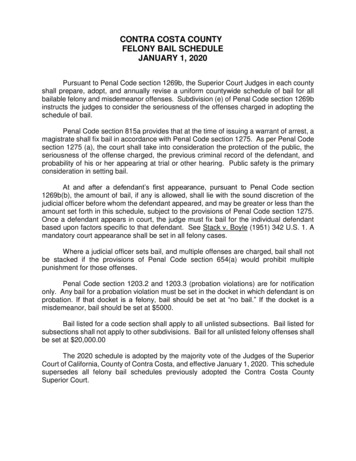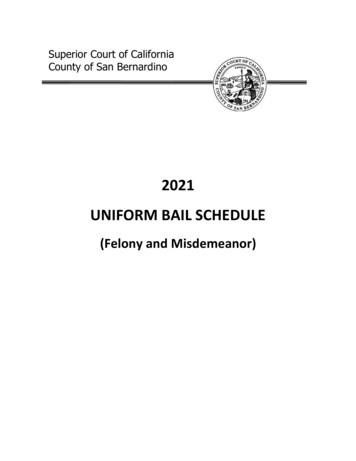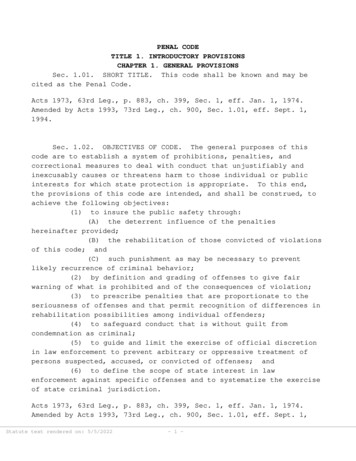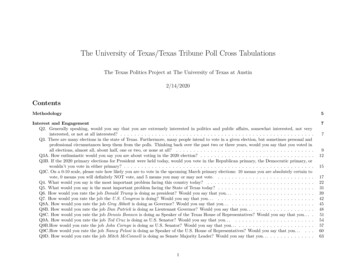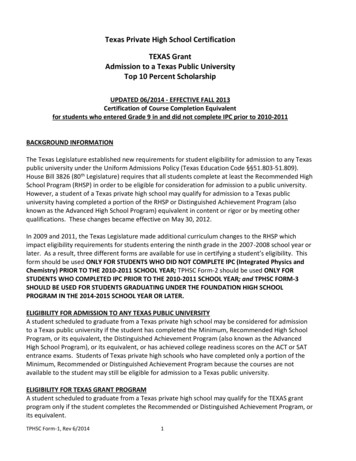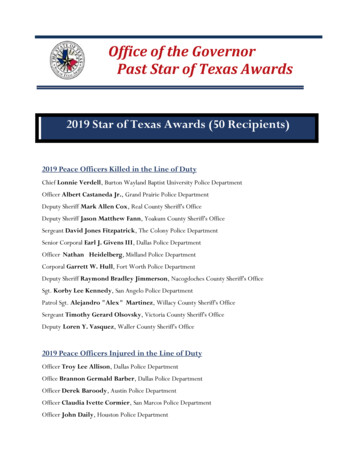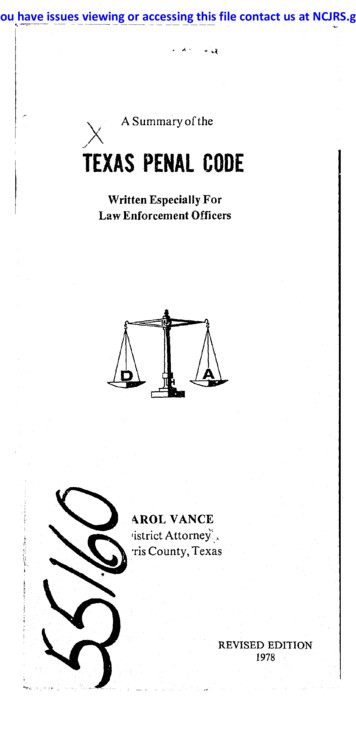
Transcription
you have issues viewing or accessing this file contact us at NCJRS.goXA Summary of the./TEXAS PENAL CODEWritten Especially ForLaw Enforcement Officers \ROL VANCElistrict Attorney'"Tis County, TexasREVISED EDITION1978
MAROFFICE OF THEDISTRICT ATTORNEYCAROL S. VANCEHarris County CourthouseHOUSTON, TEXAS 77002THE TEXAS PENAL CODEThis publication is an outline of the Texas Penal Codewhich became effective January 1, 1974. It should notbe a substitute for reference to the actual statutes. Thisguide points out the more common crimes, the statutenumbers and the penalty classifications.Besides the code, the-- re sections on major drivingoffenses, the drug laws (Controlled Substances Act),and our juvenile laws anti procedures from the FamilyCode.I hope this might be of assistance to all those involved in law enforcement.Sincerely yours,CAROL S. VANCEDistrict AttorneyHarris County, TexasPAMPHLET AMENDED TOINCLUDE LAWS EFFECTIVEIN 1978.
A SummaryoftheTEXAS PENAL CODEWritten Especially ForLaw Enforcement OfficersCAROL VANCEDistrict AttorneyHarris County, Texas3
TABLE OF CONTENTSTEXAS PENAL CODEPageTITLE 1. INTRODUCTORY PROVISIONSCHAPTER 1. General Provisions. . . . .CHAPTER 2. Burden of Proof .CHAPTER 3. MUltiple Prosecutions .101010TITLE 2. GENERAL PRINCIPLES OFCRIMINAL RESPONSIBILITYCHAPTER 6. Culpability Generally. . . . . . . . . .CHAPTER 7. Criminal Responsibility forConduct of Another .CHAPTER 8. General Defenses toCriminal Responsibility . . . . . .Section 8.01. Insanity .Section 8.04. Intoxication. . . . . . . .Section 8.06. Entrapment. . . . . . . . . . . . . . . . . .CHAPTER 9. Justification ExcludingCriminal Responsibility. . . . . .1011J111121212TITLE 3. PUNISHMENTSCHAPTER 12. Punishments.17SUBCHAPTER D. Exceptional SentencesSection 12.42. Penalties for Repeat andHabitual Felony OffendersSection 12.43. Penalties for Repeat andHabitual MisdemeanorOffenders . . . . . . . . . . . . . . . . . .Section 12.44. Reduction of Third DegreeFelony to Misdemeanor. . . . . .171718SUBCHAPTER E. Corporations and AssociationsSection 12.5!. Authorized Punishments forCorporations. . . . . . . . . . . . . . .18TITLE 4. INCHOATE OFFENSESCHAPTER IS. Preparatory Offenses .Section 15.01. Criminal Attempt . .Section 15.02; Criminal Conspiracy .Section 15.03. Criminal Solicitation .CHAPTER 16. Criminal Instruments. . . . . . .Section 16.0 I. Unlawful Use of CriminalInstrument. . . . . . . . . . . . . . . . .4181819191919
r"'.-- - -ITITLE 5. OFFENSES AGAINST THE PERSONCHAPTER 19.Section 19.01.Section 19.02.Section 19.03.Section \9.04.Sedon 19.05.Section 19.07.CHAPTER 20.'1Criminal Homicid"e .Types of Criminal Homicide .Murder. . .Capital Murder . '" . ,Voluntary Manslaughter. . . . . Involuntary Manslaughter . ,Criminally Negligent Homicide. ,Kidnappingand FalseImprisonment . , . , . , . .Section 20.02. False Imprisonment . ,.,.Section 20.03. Kidnapping. . . . . . . . . . . . . . .Section 2004. Aggravated Kidnapping. , . . . . . .CHAPTER 21. Sexual Offenses . ,.Section 21.02. Rape . , . . .Section 21.03. Aggravated Rape ,.Section 21.04. Sexual Abuse . , . . . . . . . . . . . .Section2L05. Aggravated Sexual Abuse .Section 21.06. Homosexual Conduct . . ,.Section 21.07. Public Lewdness .Section 21.08. indecent Exposure . .Section2J.09. RapeofaChiid .Section 21.10. Sexual Abuseofa Child . , . . . . .Section 21.l J. Indecency With a Child .Section 21.12. Genera! Provisions . , . . . . . . . . .CHAPTER 22. Assaultive Offenses. . . . . . . . . . . .Section 22.01. Assault . , . , ' . . . . . . .Section 22.02. Aggravated Assault .Section 22.03. Deadly Assault on aPeace Officer . . . . . . . . . . . . . . .Section 22.04. InjurytoaChild .Section 22.05. Reckless Conduct . . Section 22.07. Terroristic Threat .Section 22.08. Aiding Suicide. . . . . . . . . . . . . . . 3232323242424TITLE 6. OFFENSES AGAINST THE FAMILYCHAPTER 25. Offenses Against the Family .Section 25.0 I. Bigamy, . , . . . . . . . .Section 25.02. Incest .,.Section 25.03. Interference with Child Custody.Section25.04. Enticinga Child. . . . . . . . . . . . . . .Section 25.05. Criminal Nonsupport . ."*Section 25.06. Sale or Purchase of a Child ."*Section 25.06 Solicitation of a Child . , . . .TITLE 7. OFFENSES AGAINST PROPERTYCHAPTER 28. Arson, Criminal Mischief, andOther Property Damage otDestruction . ,.5242424242424252525 .
Section 28.01.Section28.02.Section 28.03.Section 28.04.Definitions. . . . . . . . . . . . . . . . . . .Arson. . . . . . . . . . . . . . .Criminal Mi5chief . . . . . . . . . . . . .Reck!ess Damage orDestruction .Section 28.06. Amount of Pecuniary Loss . . . . .CHAPTER 29. Robbery. . . . . . . . . . . . . . . . . . . .Section 29.02. Robbery. . . . . .Section 29.03. Aggravated Robbery .CHAPTER 30. Burglary and Criminal TrespassSection 30.02. Burglary . . . . . . . . . . . . . . . . . . . .Section 30.03. Burglary of Coin-OperatedMachines . . . . . . . . . . . . . . .Section 30.04. Burglary of Vehicles. . . . . . . . . . .Section 30.05. Criminal Trespass. . . . . . . . . . . . .CHAPTER 31. Theft.Section 31.02 Consolidation of Theft Offenses.Section 31.03. Theft. . . . . . . . . . . . . . . . . . . . . . . .Section 31.04. Theft of Service. . . . . . . . . . . . . . .Section 3 I .05. Theft of Trade Secrets. . . . . . . . .Section 31.06. Presumption for Theft by CheckSection 31.07. Unauthorized Use of a Vehicle.Section 31.08. Value.Section 31.09. Aggregation of AmountsInvolved in Theft .CHAPTER 32. 29SUBCHAPTER B. ForgerySection 32.21. Forgery. . . . . . . . . . . . . . . . . . . .Section 32.22. Criminal Simulation. . . . . . . . . . 2929SUBCHAPTER C. CreditSection 32.31. Credit Card Abuse. .Section 32.32. False Statement to ObtainProperty or Credit .Sectio.-.! 32.33. Hindering Secured Creditors .Section 32.34. Fraud in Insolvency . . . . . . . . . . .Section 32.35. Receiving Deposit, Premium, orInvestment in Failing,Financial Institution. . . . . . . . .3030303131SUBCHAPTER D. Other Deceptive 2.43.32.44.Issuance of Bad Check. . . . . . . . .Deceptive Business Practices. . . .Commercial Bribery. . . . . . . . . . .Rigging Publicly Exhibit dContest . .' . . . . . .631313232
Section 32.45. Misapplication of FiduciaryProperty or Property ofFinancial Institution. . . . . . . . .Section 32.46. Securing Execution of Documentby Deception. . . . . . . . . .Section 32.47. Fraudulent Destruction, Removal,or Concealment of Writing. .Section 32.48. Endless Chain Scheme. . . . . . . . .32323233TITLE 8. OFFENSES AGAINST THE STATEAND PUBLIC ADMINISTRATIONCHAPTER 36.Section 36.01.Section 36.02.Section 36.03.Bribery and Corrupt Influence.Definitions. . . . . . . . . . . . . .Bribery . . . . . . . . .Coercion of Public Servant orVoter . . .Section 36.04. Improper Influence. . . . . . . . . . .Section 36.05. Tampering with Witness .Section 36.06. Retaliation. . . . . . . . . . . . .Section 36.07. Compensatiun for Past OfficialBehavior. . . . . . . . . . . . . . . . . .Section 36.08. Gift to Public Servant by PersonSubject to His Jurisdiction. . .Section 36.09. Offering Gift to Public Servant.Section 36.10. Defenses . . . . . . . . . . . . . . . . . . . . .CHAPTER 37. Perjury and Other Falsification.Section 37.02 Perjury. . . . . . . . . . . . . . . . . . .Section 37.03. Aggravated Perjury .Section 37.05. Retraction .Section 37.06. Inconsistent Statements. . . . . . . .Section 37.07. Irregularities No Defense. . . . .Sectio 37.08. False Report to Peace Officer. . . .Section 37.09. Tampering with or FabricatingPhysical Evidence. . . . . . . . . . .Section 37.10. Tampering with GovernmentRecord . , . . . . . . .Section 37.11. Impersonating Public Servarlt . CHAPTER 38. Obstructing GovernmentalOperation. . . . . . . . . . . . . . . .Section 38.02. Failure to Identify as Witness. . .Section 38.03. Resisting Arrest or Search . .Section 38.04. Evading Arrest . .Section 38.05. Hindering Apprehension OrProsecution .Section 38.06. Compounding . . . . . Section 38.07. Escape.Section 38.08. Permitting or Facilitating EscapeSection 38. J I. Bail Jumping and Failure 63636363737373737377 -------------- ------ ---
Section 38.13. Hindering Proceeding byDisorderly Conduct .Section 38.14. Preventing Execution of CiyilProcess. . . . . . . . . . . . . . . . . . . .CHAPTER 39. Abuse of Office.Section 39.0 I. Official Misconduct .Section 39.02. Official Oppression. . . . . . . . . . . .Section 39.03. Misuse of Official Information. .Section 39.04. New Provision. . . . . . . . . . . . . . . .37373838383838TITLE 9. OFFENSES AGAINST PUBLICORDER AND DECENCYCHAPTER 42. Disorderly Conduct and RelatedOffenses . .Section 42.01. Disorderly Conduct .Section 42.02. Riot. . . . . . . . . . . . . .Section 42.03. Obstructing Highway or OtherPassageway .Section 42.04. Defense When Conduct Consistsof Speech or Other ExpressionSection 42.05. Disrupting Meeting orProcession . . . . . . . . .Section 42.06. False Alarm or Report .Section 42.07. Harassment .Section 42.08. Public Intoxication. . . . . . . . . . . .Section 42.09. Desecration of Venerated ObjectSection 42.10. Abuse of Corpse. . . . . . . . . . . . . .Section 42.11. Cruelty to Animals . . . . . . . . . . . .CHAPTER 43. Public Indecency. . . . . . . . . . . . . .39393940404141414141424242SUBCHAPTER A. ProstitutionSection 43.02. Prostitution. . . . . . . . . . . . . . . . . .Section 43.03. Promotion of Prostitution. . . . . .Section 43.04. Aggravated Promotion ofProstitutio'1 . . . . . . . . . . . . . . . .Section 43.05. Compelling Prostitution .Section 43.06. Accomplice Witness: Testimonyand Immunity . . . . . . . . . . . . . .4242434343SUBCHAPTER B. ObscenitySectionSectionSectionSectionDefinitions. . . . . . . . . . . . . . . . . . .Obscene Display or DistributionCommercial Obscenity. . . . . . . . .Sale, Distribution, or Display ofHarmful Material to Minor .Section 43.25. Commercial Obscenity InvolvingPerson under 17 Years of Age43.21.43.22.43.23.43.24.84343434444
-------- - TITLE 10, OFFENSES AGAINST PUBLICHEALTH, SAFETY, AND MORALSCHAPTER 46.Section 46.01.Section 46.02.Section 46.03.Section 46.04.Section 46.05.Weapons .,.Chapter Definitions . ,.,.Unlawful carrying Weapons.Non-Applicable. . . . . . . . . .Places Weapons Prohibited. . . .Unlawful Possession of Firearmby Felon.Prohibited Weapons. .Unlawful Transfer of Firearm .Gambling.Gambling. . . . . . . . . . . . . . . . . . . .Gambling Promotion. . . . . . . . . .Keeping a Gambling Place.Communicating GamblingInformation . , . . . . . . . . . . . . .Possession of Gambling Deviceor Equipment .Possession of GamblingParaphernalia .Evidence. .Testimonial Immunity. . . . ,Smoking Tobacco . " .Organized Crime. . .4545454546MAJOR DRIVIN9 OFFENSES .49TEXAS CONTROLLED SUBSTANCES ACT.51Section 46.06.Section 46.07.CHAPTER 47.Section 47.02.Section 47.03.Section 47.04.Section 47.05.Section 47.06.Section 47.07.Section 47.08.Section 47.09.Section 48.01.Section 71.02.THE TEXAS FAMILY CODEGOVERNING JUVENILE LAWS. . . . . . . . . . .Detention Facilities . . .Law Enforcement Files and Records .Fingerprints and Photographs .Sealing of Files and Records . .Public Access to Court Hearings. . . . . . . . . . . . .Appeals .Admissibility of Statements by the Juvenile .Events Prior to and Including the Referral tothe Juvenile Court . ; . ,.Taking into Custody .Warning Disposition.Procedure After a Child is Taken intoCustody . : .' . "Disposition Without Referral to Court. . . Referral to Juvenile Court ,.Release from Detention. . . . . . . . . . . . . . .Disposition by the Court. , . " . . 616263636464
TEXAS PENAL CODETITLE 1. INTRODUCTORY PROVISIONSCHAPTER 1. GENERAL PROVISIONSThis chapter explains general terms such as the effects of the Code and definitions of commonly usedterms such as "benefit," "bodily injury," "conduct,""consent," "harm," "possession," etc.CHAPTER 2. BURDEN OF PROOFThis chapter explains burden of proof, "exceptions,""defenses," "affirmative defenses," and "presumptions."Generally, the prosecution must negate any "exceptions" found in a statute in the charging instrument. Any"defense" must be raised by the evidence. And where astatute mentions an "affirmative defense," the defensemust prove this by a preponderance of the evidence asopposed to simply creating a reasonable doubt in orderto obtain an acquittal.CHAPTER 3. MULTIPLE PROSECUTIONSThis chapter explains multiple prosecutions and allows a defendant to be prosecuted for all offenses arisingout of the same criminal episode (whether the offensesare alleged in the same or separate indictments). "Criminal episode" means the repeated commission of any property crime found within Title 7. Title 7 are the offensesagainst property.TITLE 2. GENERAL PRINCIPLES OFCRIMINAL RESPONSIBILITYCHAPTER 6. CULPABILITY GENERALLYGenerally, all criminal offenses have two elements: anact and a culpable mental state. This chapter explainsthe four cUlpable mental states as follows:(1) intentionall:v - when it is his conscious objectiveor desire to engage in the conduct or cause theresult;(2) knowingly - when he is aware of the nature ofhis conduct, or the. circumstances surrounding hisconduct. or that his conduct is reasonably certainto cause the result;(3) recklessly - when he is aware of but consciouslydisregards a substantial and unjustifiable risk thatthe circumstances surrounding his conduct existor the result will occur;10
(4) criminal negligence - gross deviation from thestandard of care of an ordinary person.It should be noted that criminal negligence requires"a gross deviation from the standard of care an ordinaryperson would exercise under all the circumstances . . ."as opposed to a requirement of ordinary negligence.CHAPTER 7. CRIMINAL RESPONSIBILITYFOR CONDUCT OF ANOTHERThis chapter defines ways in which one can be a partyto an offense, replacing the traditional laws of principaland accomplice. A party is charged and punished as ifhe had committed the offense alone. One is a party if:(1) the offense is committed by his own conduct;(2) acting with the kind of culpability required forthe offense, he causes or aids an innocent or non responsible person to engage nn conduct prohibited by the definition of the offense;(3) acting with intent to promote or assist the commission of the offense, he solicits, encourages,directs, aids or attempts to aid the other person tocommit the offense; or(4) having a statutory duty to prevent commission ofthe offense and actipg with intent to promotl:! orassist its commission, he fails to make a reasonableeffort to prevent commission of the offense.If, in the attempt to carry out a conspiracy to commitone felony, another felony is committed by one of itheconspirators, all conspirators are guilty of the felonyactually committed. The fact that the co-conspirator hadno intent to commit it is no defense if it should havebeen anticipated as a natural result of engaging in theconspiracy.A corporation, as well as the individual who has theauthority and acts for or with the corporation in perpetrating the crime, is criminally responsible fot anycriminal offense. Corporations are only subject to fines.CHAPTER 8. GENERAL DEFENSES TOCRIMINAL RESPONSIBILITYSection 8.01. Imlanity - It is an affirmative defenseto prosecution that, at the time of the conduct charged,ihe actor, as a result of mental disease or defect, eitherdid not know that his conduct was wrong or was incapable of conforming his conduct to the requirements ofthe law he allegedly violated. The term "mental diseaseor defect" does not include an abnormality manifestedonly by repeated criminal or otherwise antisocial conduct.II
Section 8.04. Intoxication - Voluntary intoxicationis not a defense to a crime, and temporary insanity causedby intoxication only can be used in mitigation of punishment.Section 8,06. Entrapment - This is a defense to prosecution only if the actor engaged in the conduct becausehe was induced to do so by a law enforcement agentusing persuasion or other means likely to cause personsto commit the offense. Conduct merely affording a person an opportunity to commit an offense does not constitute entrapment.In this section "law enforcement agent" includespersonnel of the state and local law enforcement agenciesas well as of the United States and any person acting inaccordance with instructions from such agents.CHAPTER 9. JUSTIFICATION EXCLUDINGCRIMINAL RESPONSIBILITYThis chapter is especially important to the law eof orcement officer and will be dealt with in detail.All force is unlawful unless specifically justified bythe provisions of the code.Justification from criminal responsibility (as provided for in Chapter 9) speaks in terms of "force" and"deadly force" and specifies when each may be used.Therefore, if force or deadly force may be used, it mustbe specifically authorized. Our purpose in this pamphletis to reduce to more simple terms the quite complexwording of the code. However, each reader should befamiliar with the more technical wording of Chapter 9for the details ofjustification.Since the code speaks in terms of force and deadlyforce, these terms must be understood. "Deadly force" isforce that is: (1) intended to cause, or (2) knol.t'n tocause, or (3) from the manner of use or intended use iscapable of causing death or serious bodily injury. Force,of course, is any degree of force less than deadly force.When can force be legally used by police officers orby citizens?When can deadly force be used?How much force can be used and under what circumstances?Under the Penal Code, confinement (Section 9.03) istreated the same as force and is justified to the same extent. Unlawful confinement, without justification,. . would cause a person. to be guilty of false imprisonment.Also, if confinement is justified, the confinement mustbe terminated as soon as possible unless it is an arrest foran offense.12
With regard to threats (Section 9.04), a threat of forceis justified wbenever the actual use of force is justified;however, one may threaten to use deadly force, and itnot be considered the use of deadly force, as long as thepurpose is limited to creating an impression that deadlyforce will be used if necessary.Even if force, confinement, or threat of force is justified by law, if anyone recklessly injures or kills an innocent third person, then his act would not be justified bylaw (Section 9.05). For example, a police officer whoshoots at a fleeing robber on a crowded stre t wouldbe subject to pros ::ution for involuntary manslaughterfor killing a hystander. Also, it should be noted that .anyjustification under the Penal Code would not necessarily change any rights or remedies available in a civillawsuit for damages (Section 9.06).The defense of necessity (Section 9.22), conduct if theperson involved believes such conduct is immediatelynecessary to avoid imminent harm. Thus, it ultimatelyrequires the judge or jury to balance the urgency ofavoiding harm against the harm actually done by violating the law. Under the defense of necessity, consider thefollowing example. Suppose the driver of an automobilechooses to swerve and run over one person in order thathis car would miss running over and killing several otherpersons. This might well be justifiable depending on allthe facts and circumstances.In the area of self defense (Sections 9.31 and 1}.32), aperson is now justified in using only that degree of forcethat he reasonably believes necessary to protect himself.The justification relies on: (I) the existence of necessity,(2) the occasion on which force was used, (3) the degreeofforce used, and (4) the nature of the conduct to whichresponded. There are four situations in which the use offorce is not justified:(1) Verbal provocation alone does not ever merit theuse of force in response.(2) The right of self defense in order to resist an illegalarrest or search by a peace officer does not exist,unless the officer, prior to any resistance, usesgreater force than necessary. Section 38.03 makesresisting arrest a Class A misdemeanor and a thirddegree felony if a deadly weapon is used. Personsacting under the direction and in the presence of apeace officer are accorded this same protection.(3) If there was consent to the exact force used, thenforce used in retaliation is not justified. Mutualcombat is thus prohibited.13
(4) Provoking the difficulty prohibits one from usingfcrce if he had provoked the difficulty as a meansof injuring the adversary.The use of deadly force in self defense is treated separately (Section 9.32). Although deadly force can be usedto prevent the imminent commission of the crimes ofaggravated kidnapping, murder, rape, aggravated rape,robbery, and aggravated robbery, such right is not absolute in that if a reasonable person would have retreated, then the use of deadly force would not be justified. Unless it falls within the defense of property section,one cannot use deadly force to prevent theft at night orburglary.Under old Texas law, a person acting in self defensedid not have to retreat and could stand his ground, butnow a person must retreat if a reasonable person in thesame situation would have retreated.Perhaps the safest course of action is for no one to usedeadly force unless he believes (I) that his or another'slife is in jeopardy, (2) that deadly force is immediatelynecessary to preserve that life, and (3) that a reasonableperson would not have retreated.The code allows the use of force or deadly force to protect a third person under the very same conditions andwith the same restrictions that the person could haveused in defending himself (Section 9.33). Additionally,however, is the requirement that the intervention mustbe reasonably believed to be necessary to protect thethird person. Any force, short of deadly force, may beused to prevent a suicide.Both force and deadly force are justified in defense ofproperty, but under limited circumstances (Sections9.41 and 9.42).Force may be used to protect land or movable property if such force is immediately necessary to prevent orterminate another's interference with the property.If the property has been taken from the owner, thenforce may be used to regain possession if:(I) done immediately or in fresh pursuit after thetaking, and,(2) the person seeking to regain possession reasonablybelieves that the taking was not under claim ofright, or(3) the property was taken by force, threats or fraud.Deaflly force to protect property may be used if it isimmediately necessary:(1) to prevent the imminent commission of arson,14
burglary, robbery, aggravated robbery, theft during the nighttime or criminal mischief during thenighttime, or(2) to prevent escape with property taken in a burglary, robbery, aggravated robbery or theft atnight if the deadly force is exerted against the person who is fleeing immediately after committingthe offense.However, using deadly force to protect property mustalways be a last resort in that the code requires thateither thepropert)' cannot be protected or reco\'erpd byany other means or that the use of force other thandeadly force would subject oneself or another to (jsubstantial risk ofdeath or serious bodily injury.One may use any degree of force against another toprotect the property of a third person (Section 9.43)under the same rules governing the protection of hisown property if he reasonably believes that the unlawfulinterference constitutes theft or criminal mischief. Onemay also act to protect the property of a third person if:(I) such third person requested such protection, or(2) he has a legal duty to protect such property; or(3) such third person is his spouse, parent, child, orresides with or is under his care.The code permits the use of a device to protect property(S tion 9.44) only if it is not expected to cause orcreate any substantial risk of death or serious bodily injury and the use of the device is reasonable under thecircumstances. This would condone the use of barbedwire under certain circumstances but prohibits the useof a spring gun.But it must always be remembered that deadly forcewould not be justified under any of these circumstancesunless the land or property could not be protected orrecovered by eny other means.A peace officer is authorized to use force which hebelieves immediately necessary to make or assist in making an arrest or search or to prevent escape after arrest(Sections 9.51 apd 9 ,5'l). However, the officer must believe the arrest 6r!:(;;drch lawful or the warrant is validand before using force, he must identify himself as apeace officer and apprise the person of his purpose ofarrest or search. If the officer believes his identity andpurpose are already known or he cannot reasonablycommunicate these facts to the assailant (such as where.a defendant has barricaded himself some distance away),therl the officer could proceed without concern overthis requirement.15
A private person may use force which he reasonablybelieves immediately necessary to make a lawful arrestor prevent an escape after a lawful arrest if, beforeusing any force, he notifies the person to be arrested ofhis purpose and the reason for the arrest (unless he believes that such purpose and reason are already knownor cannot reasonably be made known to the person tobe arrested).In order for a peace officer to use deadly force toeffect an arrest (or to prevent escape after arrest), theofficer must reasonably believe that the conduct authorizing the arrest included the use or attempted use ofdeadly force or that there is a substantial risk of death orserious bodily injury at the hands of the person soughtto be arrested if the arrest is delayed.A private citizen cannot use deadly force in makingan arrest (or preventing an escape) unless he is in thepresence of and acting at the direction of a peace officerand (1) the citizen is making an arrest for a felony or anoffense against the pUblic peace and an arrest for whichauthorized the use or attempted use of deadly force, or(2) there is substantial risk that the person sought to bearrested will cause death or serious bodily injury toanother if arrest is delayed. There is no duty on the partof the police officer or the private citizen in making anarrest or preventing escape after arrest to retreat beforeusing deadly force.The code permits the same use of force to preventescape from custody as that used to effect the arrestunder which the person is in custody (Section 9.52).Only a peace officer or guard of a penal institution mayuse deadly force to prevent the escape from jail, prisonor other institution for the detention of persons convicted of or charged with a crime.The code justifies the use of force against a childyounger than 18 years by the child's parent, step-parentor one acting in loco parentis for the purpose of discipline or to safeguard or promote the child's welfare(Sections 9.61,9.62, and 9.63). Persons in loco parentisinclude grandparents, guardians, those acting by, throughor under the direction of a court having jurisdiction overthe child, or anyone with the express or implied consentof the parents. Presumably, this latter provision wouldcover the baby-sitter. The e ucator may use forceagainst the student, no matter what the age of the student, if the educator is entrusted with the care, supervision, or administration of the person for a specialpurpose or to maintain discipline in a group. The guardian or someone responsible for the general care and16
supervision of a mental incompetent may use force tosafeguard and promote the incompetent's welfare or ifit is an institution, to maintain discipline in the institu tion. The use of deadly force in regard to these specialrelationships is prohibited.TITLE 3. PUNISHMENTSPunishments fall into categories of Capital, First,Second and Third-Degree Felonies, or Class A, B, or CMisdemeanors. See the chart on the back cover for thepenalty ranges these classifications carry.Subchapter D. Exceptional Sentences.Section 12.42. Penalties for Repeat and HabitualFelony Offenders (a) If it be shown on the trial of a third-degree felonythat the defendant has been once before convictedof allY felony, on conviction he shall be punishedfor a second-degree felony.(b) If it be shown on the trial of a second-degreefelony that the defendant has been once beforeconvicted of any felony, on conviction he shall bepunished for a first-degree felony.(c) If it be shown on the trial of a first-degree felonythat the defendant has been once before convicted of an)' felony, on conviction he
X A Summary of the TEXAS PENAL CODE Written Especially For Law Enforcement Officers \ROL VANCE listrict Attorney'" Tis County, Texas REVISED EDITION 1978 If you have issues viewing or accessing this file contact us at NCJRS.gov.

